You have no items in your shopping cart.
0item(s)
You have no items in your shopping cart.
Despite what you may have heard, the barbell hip thrust, NOT the squat is the absolute king of glute exercises. From better muscle contraction to the ability to directly target the glutes and get unbelievable pumps, you just can’t beat the hip thrust. Combine that with the fact that the hip thrust incredibly easy to learn and safe to perform and you have a recipe for success.
The back squat should still be in your program, it’s a staple of any serious program. BUT(t) if your goal is a poppin’ backside stick to the hip thrust.
Still not convinced?
Check out this before and after picture of NPC bikini competitor Sasha Anne (@sasha_anne_fit)
The image on the left is before Sasha began incorporating the hip thrust into her training and the right is after.
[Ten Steps To The Perfect Hip Thrust]
Hip thrusts can be performed with bodyweight, barbell, or resistance band loading. The barbell hip thrust lends itself well to heavy loads, which is precisely why it’s mandatory to execute the exercise properly and master bodyweight first. Here are ten steps to the perfect hip thrust.

Pushing through the heels as opposed to through the balls of your feet shifts muscle activation away from the quadriceps and onto the glutes and hamstrings.
Make sure your heels do not rise off the ground. You can choose to maintain flat feet or to raise your toes off the ground via ankle dorsiflexion and holding that position throughout the set.

Having the shins vertical and perpendicular to the ground maximizes glute activation. Setting the feet too close to the buttocks shifts more tension onto the quads, and setting the feet too far away from the buttocks shifts more tension onto the hamstrings.
Figure out the proper foot distance so that when you’re at the top of the hip thrust, in the lockout position, your shins are vertical and not angled forward or backward.
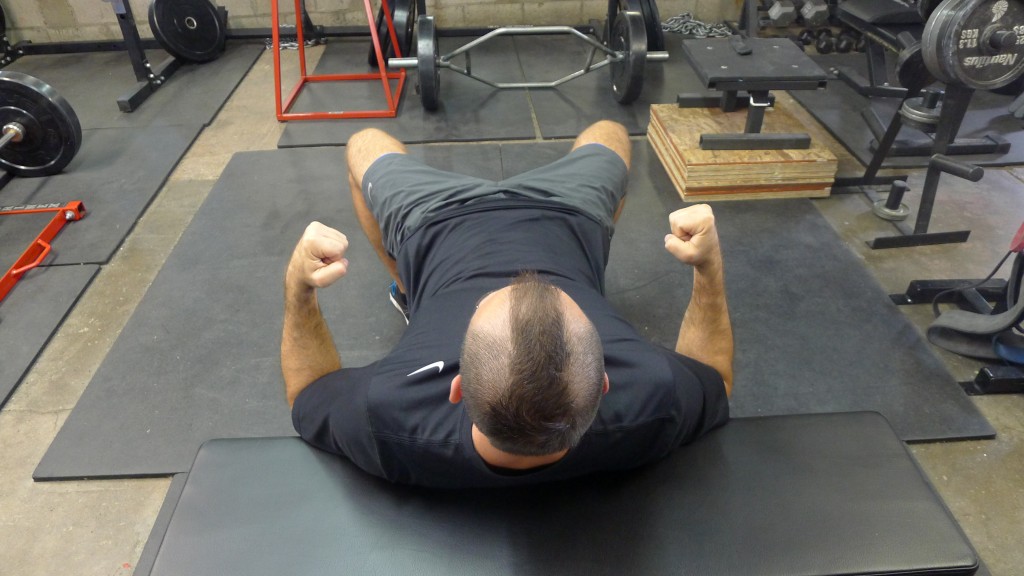
Keeping the knees out increases gluteal activation and is healthier for the knee joints.
Don’t let the knees cave inward throughout the set; keep tension on the glutes so that the femurs track in line with the feet.

Full hip extension is where the glutes achieve their highest level of activation. Failing to reach this range of motion will lead to diminished tension on the glutes.
Make sure you use the glutes to push the hips as high as possible during each repetition of the hip thrust. Don’t skimp on ROM just to perform more reps; if you can’t reach full hip extension then end the set.

Posterior pelvic tilt prevents lumbar hyperextension which isn’t ideal for spinal health, in addition to increasing glute activation.
As your hips extend and start to reach the top of the movement, think of bringing your pubic bone closer to your ribcage via gluteal contraction.
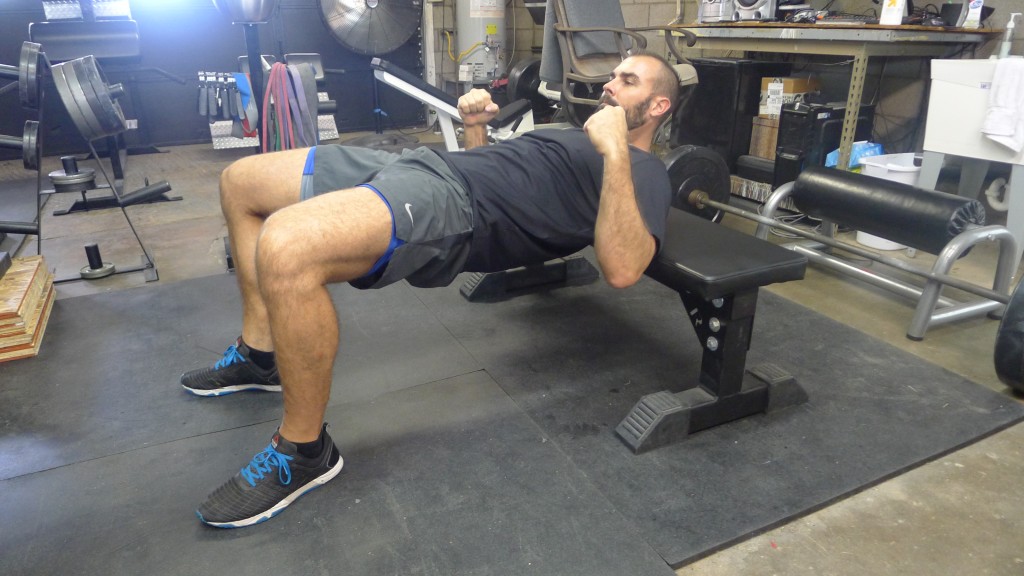
Keeping the ribs down prevents spinal hyperextension, which can be injurious to the spine over time.
Many coaches like the “chest up” cue during squats and deadlifts, but for the hip thrust this cue is the opposite of what you want. During the hip thrust, think “ribs down” so that your ribs stay glued to the pelvis throughout the movement.

A forward eye gaze encourages posterior pelvic tilt and prevents anterior pelvic tilt and lumbar hyperextension while simultaneously shifting tension onto the glutes and away from the erectors and hamstrings.
Look straight ahead when at the bottom of the hip thrust. As you rise upward, maintain your forward eye gaze which will cause your neck to flex forward during the movement.
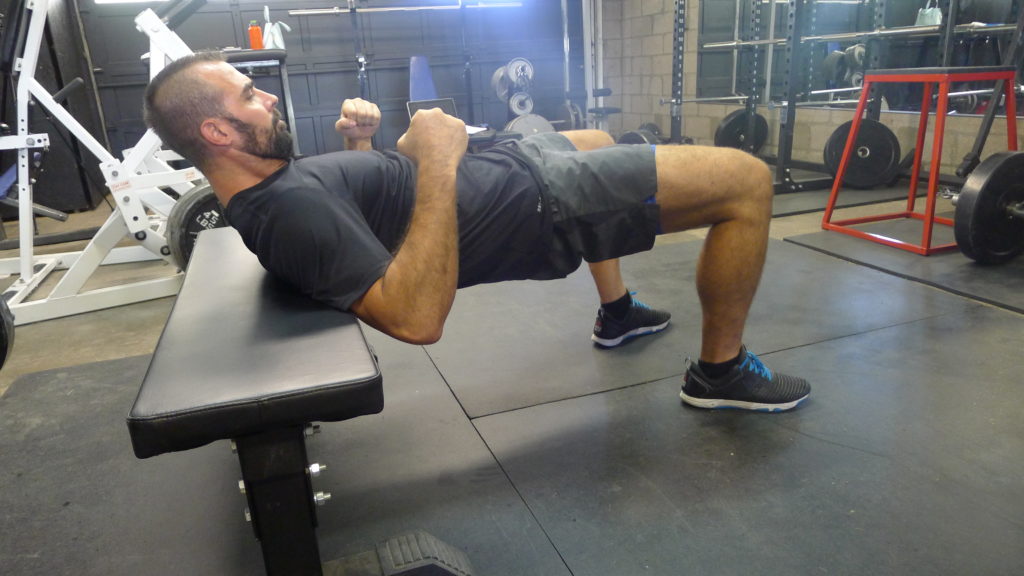
Digging the arms into the bench and making fists will increase strength and total body muscular tension through a process known as “irradiation.”
When you set up, get tight, squirm into proper position, dig your arms into the bench, and squeeze your fists together forcefully.
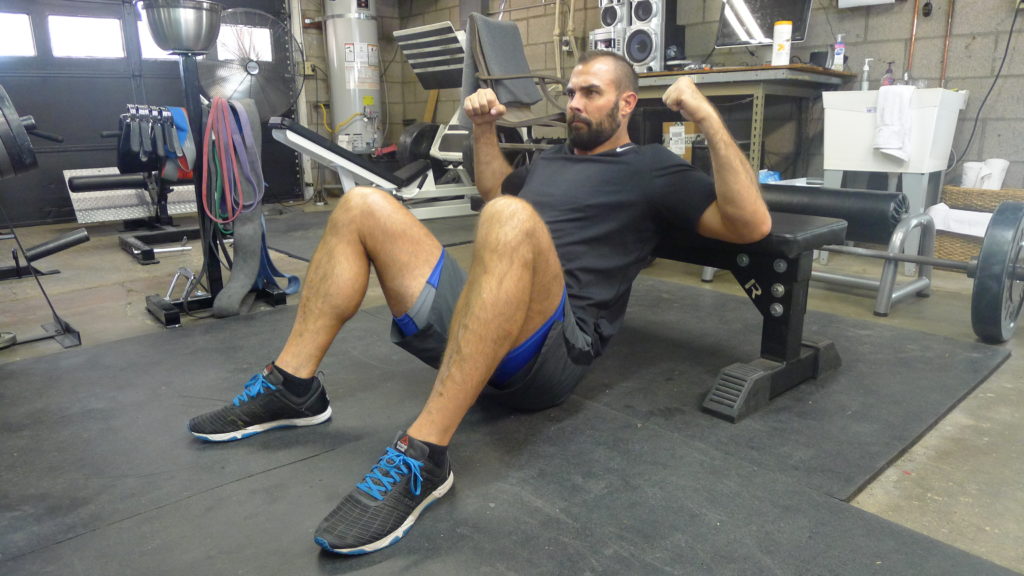
Bracing increases spinal stability, prevents hyperextension of the spine, and allows for better performance.
At the bottom of the movement, take a deep breathe and then “lock it down” by tightening the abs, obliques, and diaphragm muscles.
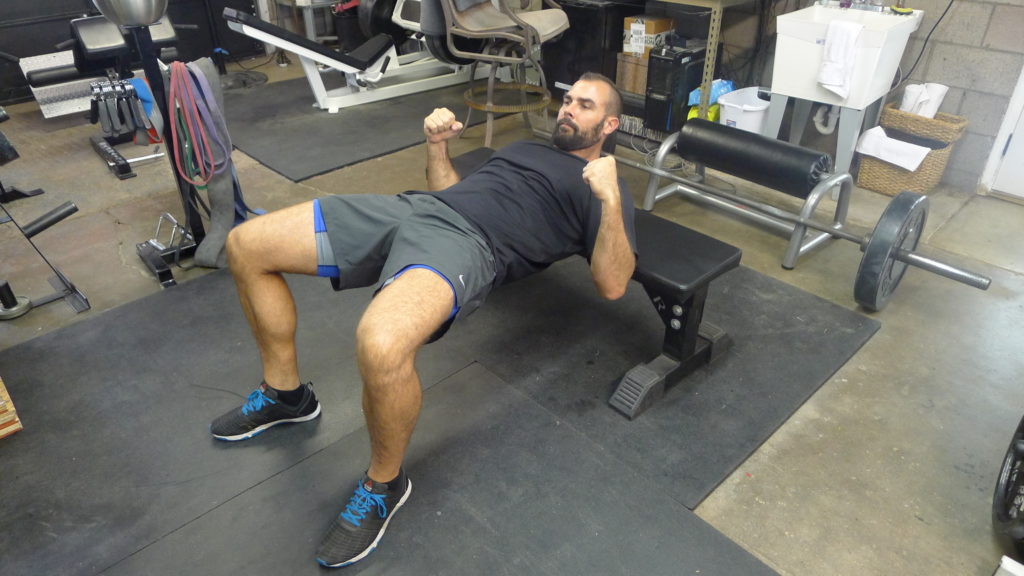
Pausing for a moment at the top of the hip thrust increases time under tension and ensures proper tempo and control throughout the movement.
At the top of each rep, squeeze the glutes and count to one before descending.
That’s it! Ten steps to a perfect hip thrust. Practice makes perfect, so get to it!
Shameless plug: You can certainly put some padding between the bar and your hips if you find Barbell Hip Thrusts painful. Our Next Gen Barbell Squat Pad is the perfect hip pad if you want to concentrate on your form without feeling any paint at all.
That’s just about it on the best exercises for your glutes. You now know how to hit your glutes with any variation regardless of the type of hip thrust These exercises are adaptable and you can perform them anywhere – it doesn’t matter if you’re in a well-equipped gym or someplace without equipment at all.
Despite what you may have heard, the barbell hip thrust, NOT the squat is the absolute king of glute exercises. From better muscle contraction to the ability to directly target the glutes and get unbelievable pumps, you just can’t beat the hip thrust. Combine that with the fact that the hip thrust incredibly easy to learn and safe to perform and you have a recipe for success.
The back squat should still be in your program, it’s a staple of any serious program. BUT(t) if your goal is a poppin’ backside stick to the hip thrust.
Still not convinced?
Check out this before and after picture of NPC bikini competitor Sasha Anne (@sasha_anne_fit)
The image on the left is before Sasha began incorporating the hip thrust into her training and the right is after.
[Ten Steps To The Perfect Hip Thrust]
Hip thrusts can be performed with bodyweight, barbell, or resistance band loading. The barbell hip thrust lends itself well to heavy loads, which is precisely why it’s mandatory to execute the exercise properly and master bodyweight first. Here are ten steps to the perfect hip thrust.

Pushing through the heels as opposed to through the balls of your feet shifts muscle activation away from the quadriceps and onto the glutes and hamstrings.
Make sure your heels do not rise off the ground. You can choose to maintain flat feet or to raise your toes off the ground via ankle dorsiflexion and holding that position throughout the set.

Having the shins vertical and perpendicular to the ground maximizes glute activation. Setting the feet too close to the buttocks shifts more tension onto the quads, and setting the feet too far away from the buttocks shifts more tension onto the hamstrings.
Figure out the proper foot distance so that when you’re at the top of the hip thrust, in the lockout position, your shins are vertical and not angled forward or backward.

Keeping the knees out increases gluteal activation and is healthier for the knee joints.
Don’t let the knees cave inward throughout the set; keep tension on the glutes so that the femurs track in line with the feet.

Full hip extension is where the glutes achieve their highest level of activation. Failing to reach this range of motion will lead to diminished tension on the glutes.
Make sure you use the glutes to push the hips as high as possible during each repetition of the hip thrust. Don’t skimp on ROM just to perform more reps; if you can’t reach full hip extension then end the set.

Posterior pelvic tilt prevents lumbar hyperextension which isn’t ideal for spinal health, in addition to increasing glute activation.
As your hips extend and start to reach the top of the movement, think of bringing your pubic bone closer to your ribcage via gluteal contraction.

Keeping the ribs down prevents spinal hyperextension, which can be injurious to the spine over time.
Many coaches like the “chest up” cue during squats and deadlifts, but for the hip thrust this cue is the opposite of what you want. During the hip thrust, think “ribs down” so that your ribs stay glued to the pelvis throughout the movement.

A forward eye gaze encourages posterior pelvic tilt and prevents anterior pelvic tilt and lumbar hyperextension while simultaneously shifting tension onto the glutes and away from the erectors and hamstrings.
Look straight ahead when at the bottom of the hip thrust. As you rise upward, maintain your forward eye gaze which will cause your neck to flex forward during the movement.

Digging the arms into the bench and making fists will increase strength and total body muscular tension through a process known as “irradiation.”
When you set up, get tight, squirm into proper position, dig your arms into the bench, and squeeze your fists together forcefully.

Bracing increases spinal stability, prevents hyperextension of the spine, and allows for better performance.
At the bottom of the movement, take a deep breathe and then “lock it down” by tightening the abs, obliques, and diaphragm muscles.

Pausing for a moment at the top of the hip thrust increases time under tension and ensures proper tempo and control throughout the movement.
At the top of each rep, squeeze the glutes and count to one before descending.
That’s it! Ten steps to a perfect hip thrust. Practice makes perfect, so get to it!
Shameless plug: You can certainly put some padding between the bar and your hips if you find Barbell Hip Thrusts painful. Our Next Gen Barbell Squat Pad is the perfect hip pad if you want to concentrate on your form without feeling any paint at all.
That’s just about it on the best exercises for your glutes. You now know how to hit your glutes with any variation regardless of the type of hip thrust These exercises are adaptable and you can perform them anywhere – it doesn’t matter if you’re in a well-equipped gym or someplace without equipment at all.
← Older Post Newer Post →